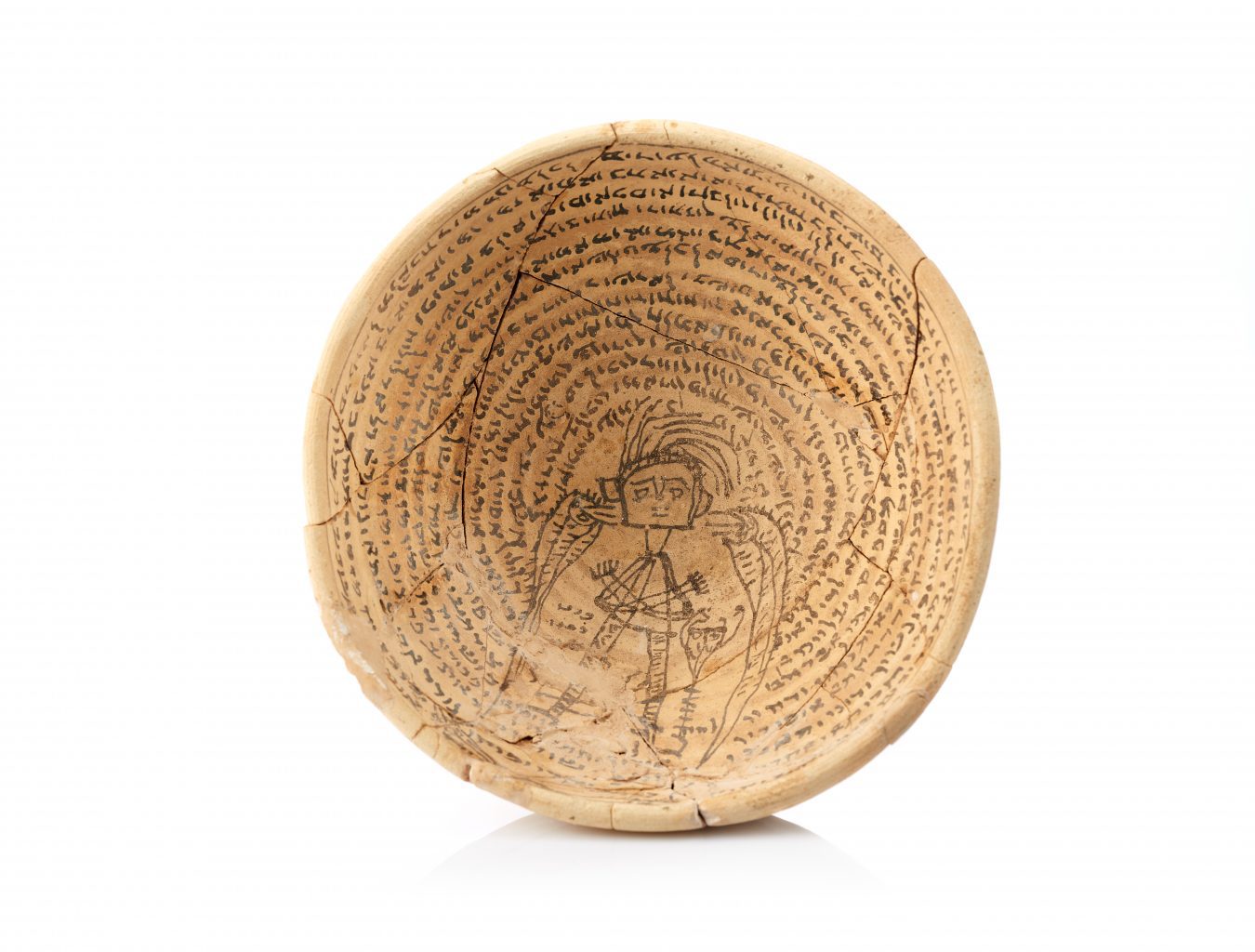Incantation Bowl
Iraq, 5th-7th centuries CE
Ink on burnt clay
Museum Collection
Incantation bowls in Babylonia were considered amulets. They were fabricated from clay and had blessings and sacred texts written on them. Between the 4th and 8th centuries CE, these bowls would be buried face down on the threshold of the house to capture and subdue demons. This incantation bowl bears an inscription written in Jewish Babylonian Aramaic, appealing to the angel, Sarfiel, to expel two demons from the home of Kafnai ben Imma and his wife, Imai bat Annai. The demon depicted in the center of the bowl has hollow eyes, crossed arms, chained legs, and disheveled hair. he is surrounded by two serpent figures; a third figure stands to his left with his hands held up in surrender
Must Know
Incantation bowls are clay bowls made in Babylon from the 4th to the 7th centuries. There are blessings, curses and magical formulas inscribed in them as they served as a type of amulet. Mostly, they were buried faced down under the house and served as a kind of demon trap because of their concave position that captures the demons inside. Usually, there is a simple illustration in the center of the bowl, mostly of a demon with bound hands, wild hair, and expressionless face, and a spiral inscription moves from the center towards the rim of the bowl. The bowl fights all the demons, diseases, and evil events which both the Jewish and the gentile population in Babylon were exposed to and it protects the owner of the bowl from all evil events.
Many incantation bowls, written in Jewish Aramaic, were found in Babylon. They can teach us about the Jewish culture in the Talmudic period. They also show that there was a strong connection between the sages and the bowl makers. The bowls contain many quotes from biblical verses, blessings, prayers, they use the language of the Mishna, words like “Hallelujah” or “Saleh”, and the names of famous rabbis. In the Talmud and in additional sources, we can find information about demons, their descriptions and how to protect ourselves against them. According to the Jewish tradition “you shall not make for yourself any statue or idol”, the demons were not depicted. Still, demonic figures were painted on the Babylonian Jewish incantation bowls. The rabbis allowed the Jews to paint demons as a way of dealing with the new Christian religion which was spreading quickly.
More Info
In the 3rd century AD, there was an ongoing state of war in the Sasanian Empire and many men were absent from home. As a result, the women who remained home took on their tasks and religious roles, managed financially, and studied. As a result, it increased the percentage of literate women and even improved their legal status.
The Babylonian Talmud was written in the same period and provides evidence for the fact that women were experts in magic. It is believed that the rabbis tried to have monopoly on magic. Magic items were sold on the market by both men and women. The rabbis tried to sabotage magical products with literary orientation (reading and writing). Although both genders engaged in the same type of magic, the magic of men was considered as the legitimate one, because its power derived from the Torah and from the names of God, while the magic of women was rejected, because it was associated with Mesopotamian elements.
In times of difficulties, it was customary in the Jewish world to persevere in prayers, to keep the mitzvot and to perform good deeds in the eye of God. However, the bowls teach us that in times of distress, the Jews, similarly to their tyrannic Babylonian neighbors, turned to the amulets that protected them from demons. The bowls were designed to protect one person according to his name. We can learn from the bowls that the Babylonian Jews adopted Babylonian names like Aroch (“Long”), enosh (“Human”), or Baruch (“First-born”) etc. The inscribed magical formula showed many names, the names of those who purchased the bowls and the nicknames they used, the names of the demons who troubled them (Shadin, Divin, Pagin, Stanin, Ishtar and Lilith), popular names of helping essences and angels (Gabriel, Michael, Raphael, Nuriel and Metatron), the names of characters in the Old Testament (Moses, King Solomon, Elijah the Prophet, Esther), and the names of rabbis with magical aura (Hanina ben Dosa and Joshua ben Perachiah). However, the name of the magician, that is the person who wrote the spell itself, was almost never written on the bowl. Although, it was presumed that most of the writers were male rabbis, proof has been found that a small number of bowls whose writers were actually women. There are several demons who are known by name, the first one is Lilith who is also mentioned in the Talmud. She derives from two Sumerian demons. For her feast, she suffocates women and babies at the childbirth, and seduces and kills young men. The male demons, like Samael or Ashmedai, are known as the angels of death. They are characterized by horns and a royal crown. Their cloths are identical to that of the Persian kings of the period. Today, modern demon depictions often use horns, tail and animal legs.
Nowadays, the public’s interest in “Baal Shem”, “The Righteous”, ”The Kabbalists”, ”The Patriarchs”, “The Saints” etc., has grown recently and it has become a widespread phenomenon to turn to these persons, not only in Israel. They offer “blessings” (and sometimes “curses”) as well as protection against demons, evil spirits, the evil eye, diseases, and other harms. The target audience might be common people, as well as powerful political leaders. Those who turn to these people can be sure that whatever they ask for, a solution can be found with their help.

